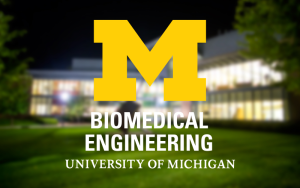Presented By: Biomedical Engineering
Approaches to Prevascularize Pancreatic Islets: A Preliminary Study for Diabetic Cell Therapy
BME Master's Defense: Huy Vu

This research is seeking to examine two approaches to vascularize a scaffold material, toward the goal of engineering a prevascularized islet implant. Type 1 diabetes mellitus (T1DM) is a chronic condition that affects millions of people worldwide. It is indicated by the autoimmune destruction of beta cells within pancreatic islets which results in significantly decreased or no production of insulin. Without enough insulin, the body cannot maintain healthy blood glucose levels, and this deficiency can lead to a range of other issues. A previous cell therapy method has been established to attempt to permanently cure T1DM, but the need for harsh immunosuppressive drugs, as well as poor vascularization, keep this protocol from being widely used. The scaffold vascularization strategies utilized in this research aim to mitigate the negative aspects of this preceding protocol.
The first part of this study characterized the effects of cell-specific media formulations on in vitro endothelial network development. In these experiments, hybrid media formulations containing varying ratios of vascular growth medium and beta cell medium were used to culture cellular fibrin hydrogels for 5 and 7 days. 3D vessel density analysis was performed for each gel, and the results showed that increasing the amount of beta cell medium in the gel culture media significantly decreased overall vessel density, and decreased vessel growth between day 5 and 7.
The second part of this study evaluated how the extent of in vitro endothelial network development in 3D fibrin hydrogels was affected by applying a modular tissue engineering strategy. Cellular fibrin microbeads were fabricated for this experiment. One group was immediately embedded into fibrin hydrogels, and a second group was kept in preculture for 5 days before being embedded. These embedded hydrogels were allowed to culture for 7 days before being analyzed for extent of vascularization. Average vessel sprout lengths were determined for each experimental group and compared, and the results of this study showed that the precultured microbeads were able to sprout statistically significantly longer vessels than non-precultured microbeads by the end of the 7-day culture period.
These studies help to demonstrate directions that could be pursued to develop a successful method for pre-vascularizing islet implants. The islet beta cell medium is not well suited for vascularization strategies because it lacks growth factors and supplements needed for endothelial network development. Because the islet’s media environment is incompatible with direct endothelial network growth, utilizing a precultured microtissue within an islet-containing hydrogel could aid in network growth even with beta cell medium. The microtissue itself serves as a temporary environment for an endothelial network to form before being exposed to beta medium, and the preformed endothelial network is beneficial in promoting vessel sprouting mechanisms and secreting proangiogenic factors lacking in the beta cell medium. Overall, incorporating precultured microtissues to vascularize islets could be a promising step towards treating T1DM.
DATE: Monday, March 21, 2002
TIME: 3:00 PM
Zoom: https://umich.zoom.us/j/8624071458 (Passcode: 932317)
Chair: Prof. Jan Stegemann
The first part of this study characterized the effects of cell-specific media formulations on in vitro endothelial network development. In these experiments, hybrid media formulations containing varying ratios of vascular growth medium and beta cell medium were used to culture cellular fibrin hydrogels for 5 and 7 days. 3D vessel density analysis was performed for each gel, and the results showed that increasing the amount of beta cell medium in the gel culture media significantly decreased overall vessel density, and decreased vessel growth between day 5 and 7.
The second part of this study evaluated how the extent of in vitro endothelial network development in 3D fibrin hydrogels was affected by applying a modular tissue engineering strategy. Cellular fibrin microbeads were fabricated for this experiment. One group was immediately embedded into fibrin hydrogels, and a second group was kept in preculture for 5 days before being embedded. These embedded hydrogels were allowed to culture for 7 days before being analyzed for extent of vascularization. Average vessel sprout lengths were determined for each experimental group and compared, and the results of this study showed that the precultured microbeads were able to sprout statistically significantly longer vessels than non-precultured microbeads by the end of the 7-day culture period.
These studies help to demonstrate directions that could be pursued to develop a successful method for pre-vascularizing islet implants. The islet beta cell medium is not well suited for vascularization strategies because it lacks growth factors and supplements needed for endothelial network development. Because the islet’s media environment is incompatible with direct endothelial network growth, utilizing a precultured microtissue within an islet-containing hydrogel could aid in network growth even with beta cell medium. The microtissue itself serves as a temporary environment for an endothelial network to form before being exposed to beta medium, and the preformed endothelial network is beneficial in promoting vessel sprouting mechanisms and secreting proangiogenic factors lacking in the beta cell medium. Overall, incorporating precultured microtissues to vascularize islets could be a promising step towards treating T1DM.
DATE: Monday, March 21, 2002
TIME: 3:00 PM
Zoom: https://umich.zoom.us/j/8624071458 (Passcode: 932317)
Chair: Prof. Jan Stegemann